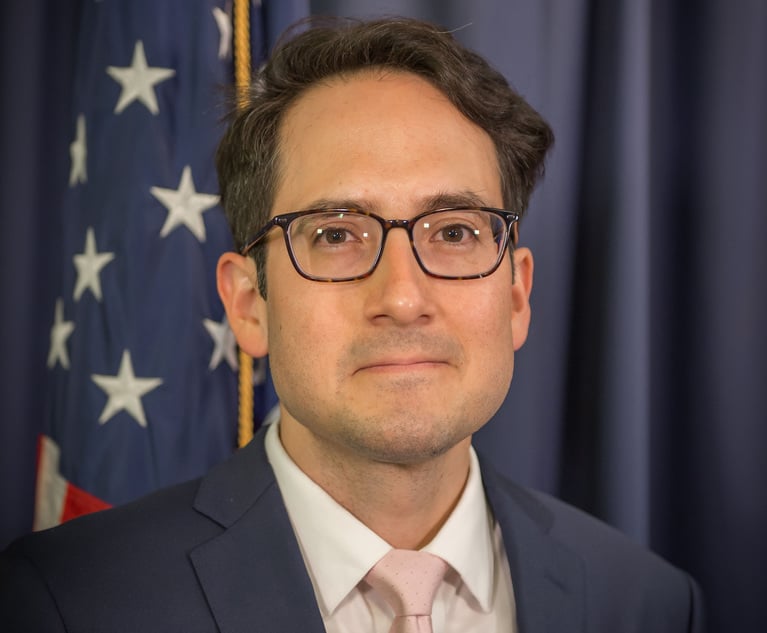Technology: Balancing data analytics, data privacy and e-discovery
Robust new data analytics have complicated company data maintenance policies.
August 16, 2013 at 09:23 AM
5 minute read
The original version of this story was published on Law.com
Robust new data analytics have complicated company data maintenance policies. Increasingly powerful platforms now offer business decision makers in-depth, highly detailed insights into the factors that motivate customers and consumers. But businesses that want to use data analytics must often comply with data privacy rules regarding the retention and disclosure of certain kinds of personal information, known as Personally Identifiable Information (PII). At the same time, businesses need to also adhere to the clearer guidelines on corporate data preservation duties developed as part of e-discovery's emerging jurisprudence. Balancing these data-driven issues requires an understanding of the ever-evolving landscape of each competing concern.
Data analytics meets data privacy
Data analytics use captured data, statistics, algorithms and other mathematical tools to improve decision making. In analytics, data value increases with specificity. Every time data gets filtered, its analytic value diminishes. Thus, businesses that want to increase the reliability of the predictive conclusion reached by their analytics often seek to maintain and use as much data as possible.
Yet ethical and privacy considerations push against analytics' full capabilities. Governments and regulatory agencies have drafted a wide range of data privacy rules, regulations, laws, directives and frameworks in an effort to address the concerns data use creates. In the European Union, the EU Data Protection Directive (1995) and the Organization for Economic Co-operation and Development (OECD) Guidelines (1980) create one set of requirements to protect information that qualifies as PII. The Asian-Pacific Economic Cooperation (APEC) crafted the APEC Framework, a less well-defined set of guidelines for the protection and use of PII. The U.S. is a member of APEC and signed the APEC Framework.
Within the U.S., a variety of federal and state laws and regulations control business use of PII, often tied to a particular sector or industry. Examples include the Video Privacy Protection Act (VPPA) of 1988, the Cable Television Protection and Competition Act of 1992, the Fair Credit Reporting Act, the Children's Online Privacy Protection Act, and the Health Insurance Portability and Accountability Act (HIPAA). Additionally, the Stored Communications Act of 1986 defines privacy rights in data stored by third parties like cell phone companies and social media sites like Facebook and Twitter. There's also recently introduced but non-binding Federal Trade Commission recommendations on data privacy, pending federal data privacy legislation and individual state data privacy laws in all but four states. Each has sometimes differing rules and recommendations regarding the protection and disclosure of PII.
E-discovery and data privacy
In the last few years, e-discovery litigation has revealed a set of best practices that give guidance to businesses seeking to gain control of potentially discoverable electronically stored information (ESI). These practices—often led by corporate general counsel—call for the design and implementation of data retention policies that plan for the regular review and elimination of unnecessary data. Policies that allow too much data to accumulate may increase the cost of future, unanticipated litigation. Conversely, failure to retain enough data may lead to accusations of spoliation and all its attendant consequences.
Data privacy considerations can complicate data retention policies. Data privacy laws may impose retention limitations at odds with data holds and litigation needs. For example, the VPPA and similar state laws set limits on the amount of time data regarding video rentals may be retained. Other privacy laws explicitly limit the disclosure of PII that may otherwise qualify as relevant, discoverable ESI. Employee records containing privileged HIPPA information serve as an easy, but not singular example.
Adding data analytics into the mix requires a further risk-benefit assessment. Businesses may have to decide whether or not keeping data containing PII pushes the limits of best practices for e-discovery. They may also have to determine how to meet obligations to protect PII in legitimately retained data from prohibited disclosures in litigation.
Putting it all together
Insights gained from e-discovery practice can help companies navigate the complicated intersection of privacy, litigation and ongoing needs for data analytics. Suggested practices include:
- Creation of data privacy policies that comply with the standards of all potentially affected markets—including international ones.
- Early use of custodian interviews and other established e-discovery tools to identify data sources containing PII that data privacy laws protect.
- Adding PII to the list of private or privileged information to be discussed at Rule 26(f) Meet and Confers or covered by judicial protective orders.
Data proliferation offers businesses both opportunities and challenges. Better technologies have created new ways to mine records for insights on critical business decisions and directions. At the same time, companies have learned that keeping unnecessary data can create unanticipated problems in litigation. By recognizing the multiple and competing issues involved, businesses can create a plan that lets them make the best use of their data and defend that use no matter the challenge that comes.
This content has been archived. It is available through our partners, LexisNexis® and Bloomberg Law.
To view this content, please continue to their sites.
Not a Lexis Subscriber?
Subscribe Now
Not a Bloomberg Law Subscriber?
Subscribe Now
NOT FOR REPRINT
© 2025 ALM Global, LLC, All Rights Reserved. Request academic re-use from www.copyright.com. All other uses, submit a request to [email protected]. For more information visit Asset & Logo Licensing.
You Might Like
View All
GOP Now Holds FTC Gavel, but Dems Signal They'll Be a Rowdy Minority
6 minute read
Trump's Inspectors General Purge Could Make Policy Changes Easier, Observers Say

Keys to Maximizing Efficiency (and Vibes) When Navigating International Trade Compliance Crosschecks
6 minute read
Crypto Industry Eyes Legislation to Clarify Regulatory Framework
Trending Stories
- 1Loopholes, DNA Collection and Tech: Does Your Consent as a User of a Genealogy Website Override Another Person’s Fourth Amendment Right?
- 2Free Microsoft Browser Extension Is Costing Content Creators, Class Action Claims
- 3Reshaping IP Policy Under the Second Trump Administration
- 4Lawyers' Reenactment Footage Leads to $1.5M Settlement
- 5People in the News—Feb. 4, 2025—McGuireWoods, Barley Snyder
Who Got The Work
J. Brugh Lower of Gibbons has entered an appearance for industrial equipment supplier Devco Corporation in a pending trademark infringement lawsuit. The suit, accusing the defendant of selling knock-off Graco products, was filed Dec. 18 in New Jersey District Court by Rivkin Radler on behalf of Graco Inc. and Graco Minnesota. The case, assigned to U.S. District Judge Zahid N. Quraishi, is 3:24-cv-11294, Graco Inc. et al v. Devco Corporation.
Who Got The Work
Rebecca Maller-Stein and Kent A. Yalowitz of Arnold & Porter Kaye Scholer have entered their appearances for Hanaco Venture Capital and its executives, Lior Prosor and David Frankel, in a pending securities lawsuit. The action, filed on Dec. 24 in New York Southern District Court by Zell, Aron & Co. on behalf of Goldeneye Advisors, accuses the defendants of negligently and fraudulently managing the plaintiff's $1 million investment. The case, assigned to U.S. District Judge Vernon S. Broderick, is 1:24-cv-09918, Goldeneye Advisors, LLC v. Hanaco Venture Capital, Ltd. et al.
Who Got The Work
Attorneys from A&O Shearman has stepped in as defense counsel for Toronto-Dominion Bank and other defendants in a pending securities class action. The suit, filed Dec. 11 in New York Southern District Court by Bleichmar Fonti & Auld, accuses the defendants of concealing the bank's 'pervasive' deficiencies in regards to its compliance with the Bank Secrecy Act and the quality of its anti-money laundering controls. The case, assigned to U.S. District Judge Arun Subramanian, is 1:24-cv-09445, Gonzalez v. The Toronto-Dominion Bank et al.
Who Got The Work
Crown Castle International, a Pennsylvania company providing shared communications infrastructure, has turned to Luke D. Wolf of Gordon Rees Scully Mansukhani to fend off a pending breach-of-contract lawsuit. The court action, filed Nov. 25 in Michigan Eastern District Court by Hooper Hathaway PC on behalf of The Town Residences LLC, accuses Crown Castle of failing to transfer approximately $30,000 in utility payments from T-Mobile in breach of a roof-top lease and assignment agreement. The case, assigned to U.S. District Judge Susan K. Declercq, is 2:24-cv-13131, The Town Residences LLC v. T-Mobile US, Inc. et al.
Who Got The Work
Wilfred P. Coronato and Daniel M. Schwartz of McCarter & English have stepped in as defense counsel to Electrolux Home Products Inc. in a pending product liability lawsuit. The court action, filed Nov. 26 in New York Eastern District Court by Poulos Lopiccolo PC and Nagel Rice LLP on behalf of David Stern, alleges that the defendant's refrigerators’ drawers and shelving repeatedly break and fall apart within months after purchase. The case, assigned to U.S. District Judge Joan M. Azrack, is 2:24-cv-08204, Stern v. Electrolux Home Products, Inc.
Featured Firms
Law Offices of Gary Martin Hays & Associates, P.C.
(470) 294-1674
Law Offices of Mark E. Salomone
(857) 444-6468
Smith & Hassler
(713) 739-1250






